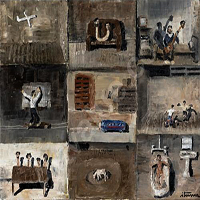Iturria's Altered World
 Ignacio Iturria (Montevideo, 1949-) is arguably Uruguay's most prominent contemporary artist. The irony of course is that his work is more identifiable as 20th century modern or post-modern art. But there he is with all of his 63 years still leading many art conversations almost two decades after garnering a major award while representing his country at the '95 Venice Biennial.
Ignacio Iturria (Montevideo, 1949-) is arguably Uruguay's most prominent contemporary artist. The irony of course is that his work is more identifiable as 20th century modern or post-modern art. But there he is with all of his 63 years still leading many art conversations almost two decades after garnering a major award while representing his country at the '95 Venice Biennial.
That's a good thing.
The attraction to Iturria's work is its charming sincerity and lack of pretentiousness. It is what it is, and that's just fine for Ignacio and his legions of admirers. Where many contemporaries have veered towards vapid kitsch, spineless shock or mind-numbing concepts that create only confusing disengagement rather than visual connection, Iturria's work involves a clear mandate sans the haughty intellectual stuffiness. That's not to say it isn't deep. Iturria doesn't ambush his viewers with after-the-fact semantic jabberwocky. It is accessible for most viewers and readily identifiable as a proud standard bearer for the quirks and idiosyncracies of his beloved home region. His paintings are both serious and jovial. Although decidely personal, they speak for the people through his dream-like characters, slapstick displacement of seemingly unrelated imagery and populist iconogaphy. Its symbolism is not meant to puzzle, rather it serves as allegories of very real circumstances that affect both he and his compatriots.
 Simply put, Ignacio Iturria's work is fun, melancholic and nostalgic. Whimsical characters laid out with chunky paint seem poised to jump off the canvas from teetering tables, wrought iron balconies or crooked shelves... at least those not already swirling in water sinks. His carefully constructed dream world includes both past and present. One immediately notices the animals that set his work as an altered reality, but they are anchored by depictions of prevalent nautical life that ties the work to this maritime country or settings based on recognizable objects from every local household. Family portraits on the wall and football icons on shelves leave no doubt to the source of Iturria's inspirations, all laid out in the somber color space readily identifiable by anyone who has visited Uruguay's main city and witnessed its reduced tonal range and distinct light. While many contemporary artists have broken away from the Southern School's palette with a somewhat faddish and contrived chromatic revolution, Iturria's use of color seems somehow more honest despite its roots in a past that many choose to forget.
Simply put, Ignacio Iturria's work is fun, melancholic and nostalgic. Whimsical characters laid out with chunky paint seem poised to jump off the canvas from teetering tables, wrought iron balconies or crooked shelves... at least those not already swirling in water sinks. His carefully constructed dream world includes both past and present. One immediately notices the animals that set his work as an altered reality, but they are anchored by depictions of prevalent nautical life that ties the work to this maritime country or settings based on recognizable objects from every local household. Family portraits on the wall and football icons on shelves leave no doubt to the source of Iturria's inspirations, all laid out in the somber color space readily identifiable by anyone who has visited Uruguay's main city and witnessed its reduced tonal range and distinct light. While many contemporary artists have broken away from the Southern School's palette with a somewhat faddish and contrived chromatic revolution, Iturria's use of color seems somehow more honest despite its roots in a past that many choose to forget.
Ignacio Iturria's work offers comfort for despair, hope for the frustrated and celebration for the triumphant, a fitting represention for a small nation with a checkered history but a potentially promising future.
Resources:


































